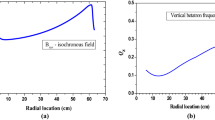Abstract
Background
In a beam cycle, there is a chicane bump (BC bump) in the injection region of the China Spallation Neutron Source (CSNS). It is a core part of the injection system and the important guarantee that the Linac beam injecting into the rapid cycling synchrotron (RCS). During the beam commissioning, the residual orbit of BC bump, i.e., the closed-orbit distortion (COD) due to the imperfect BC bump, was an important problem which can affect the orbit correction and beam loss control of the RCS.
Purpose
The purpose is to develop a suitable method to judge and correct the residual orbit of BC bump.
Methods
According to the physics design, there is no residual orbit of BC bump in theory. However, if the residual orbit of BC bump exists in the actual operation, the circular beam orbit outside the injection region would be affected. By comparing the circular beam orbit outside the BC bump region in theory and that is measured in the actual operation, whether the residual orbit of BC bump exists can be judged. By using the three auxiliary windings of BC magnets, the residual orbit of BC bump can be corrected.
Results
The numerical simulation results showed that the measurement and correction methods had worked well and they can be applied to the beam commissioning of CSNS/RCS. The measurement results in the machine study showed that the residual orbit of BC bump is not large and can be reduced by the three auxiliary windings of BC magnets.
Conclusion
The methods to judge and correct the residual orbit of BC bump worked well and had been applied to the beam commissioning of CSNS/RCS.






Similar content being viewed by others
References
S. Wang, S.X. Fang, Q. Qin, J.Y. Tang, J. Wei, Introduction to the overall physics design of CSNS accelerators. Chin. Phys. C 33, 1 (2009)
J. Wei, S.N. Fu, J.Y. Tang, J.Z. Tao, D.S. Wang, F.W. Wang, S. Wang, China spallation neutron source—an overview of application prospects. Chin. Phys. C 33, 1033 (2009)
CSNS Project Team, China Spallation Neutron Source Feasibility Research Report (2009) (in Chinese)
J.Y. Tang, J. Qiu, S. Wang, J. Wei, Physics design and study of the BSNS RCS injection system. High Energy Phys Nuclear Phys. 30, 1184 (2006)
M.Y. Huang, S. Wang, J. Qiu, N. Wang, S.Y. Xu, Effects of injection beam parameters and foil scattering for CSNS/RCS. Chin. Phys. C 37, 067001 (2013)
X.H. Lu, M.Y. Huang, S. Wang, Injection orbit matching for a rapid cycling synchrotron. Phys. Rev. Accel. Beams 21, 062802 (2018)
M.Y. Huang, H.C. Liu, S. Wang, et al., Study on the fixed point injection during the beam commissioning for CSNS, in Proceedings of IPAC2018, Vancouver, BC, Canada (2018), pp. 1017–1019
M. Y. Huang, S. Wang, S.Y. Xu, Study on phase space painting during the beam commissioning for CSNS, in Proceedings of HB2018, Daejeon, Korea (2018), pp. 309–311
J. Galambos, C.M. Chu, W.D. Klotz et al., XAL application programming framework, in Proceedings of ICALEPCS’03, Gyeongju, Korea (2003), pp. 332–336
M.Y. Huang, S. Wang, W.B. Liu et al., Study on the injection beam commissioning software for CSNS/RCS, in Proceedings of IPAC2015, Richmond, VA, USA (2015), pp. 950–952
X.H. Lu, J.L. Chen, S.Y. Xu, M.Y. Huang, Y.W. An, S. Wang, The development of perturbation model for fringe field in Open XAL and its application in the beam commissioning of CSNS. Radiat. Detect. Technol. Methods 2, 34 (2018)
Private communication with T.G. Xu and J.L. Sun who are the leaders of CSNS beam diagnostics system indicates that the precisions of the BPMs are around 1 mm
M.Y. Huang, S.N. Fu, N. Huang et al., Study on the magnetic measurement results of the injection system for CSNS/RCS, in Proceedings of HB2016, Malmo, Sweden (2016), pp. 46–48
Acknowledgements
The authors would like to thank T.G. Xu, J.L. Sun and other CSNS colleagues for the discussions and consultations.
Funding
Funding was provided by National Natural Science Foundation of China (Grant No. U1832210).
Author information
Authors and Affiliations
Corresponding author
Rights and permissions
About this article
Cite this article
Huang, MY., Wang, S. & Xu, S. Residual orbit of BC bump for CSNS/RCS. Radiat Detect Technol Methods 3, 50 (2019). https://doi.org/10.1007/s41605-019-0128-9
Received:
Revised:
Accepted:
Published:
DOI: https://doi.org/10.1007/s41605-019-0128-9




